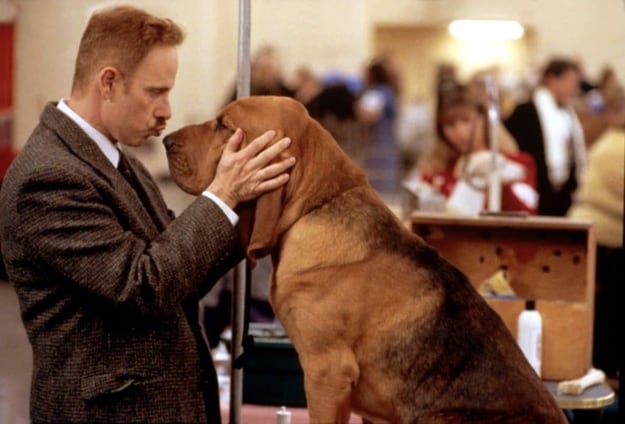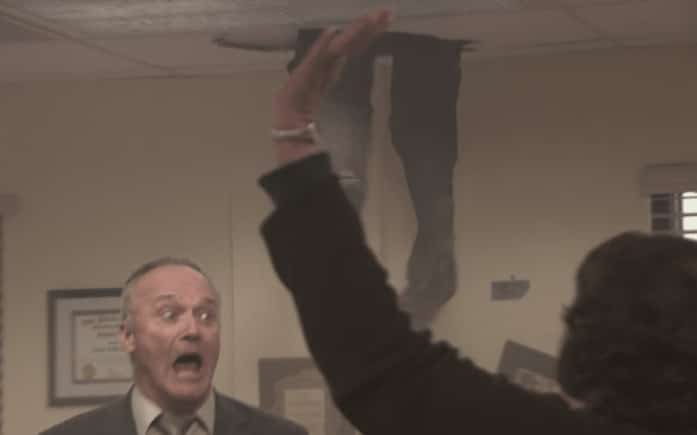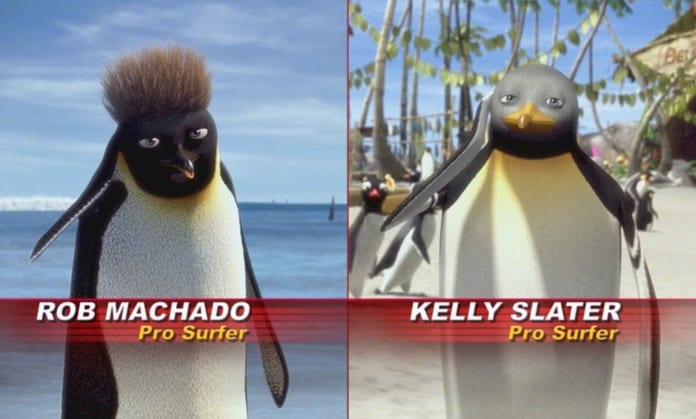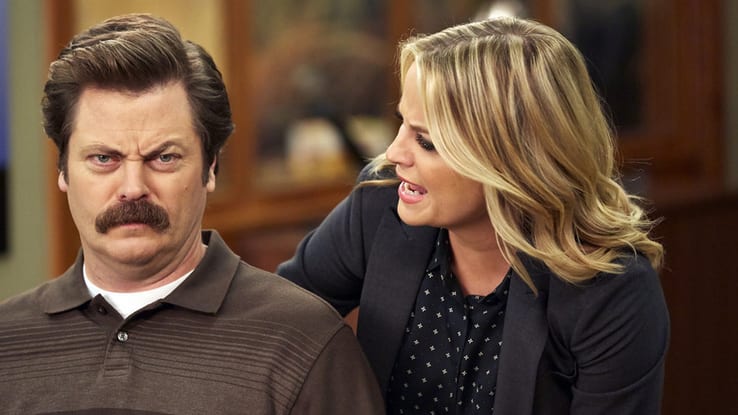A mockumentary is a satirical film or television show that combines documentary-style filmmaking with fictional subject matter. But although mockumentaries feature fictional events, they differ greatly from traditional narratives. And this can manifest in a mockumentary script.
Improvisation is often a major aspect of the mockumentary. In this case, the dialogue is secondary to the topic and characters. For example, the Christopher Guest classic THIS IS SPINAL TAP is based on a four-page script and a character bible, meaning it was almost entirely improvised.
The structure of mockumentary scripts is also subordinate to other elements like tone and style. Think of BEST IN SHOW, which spends most of its runtime introducing and developing the dog-owners rather than focusing on plot.
However, the mockumentary script is underrated and often ignored. Often times mockumentaries, whilst seeming to rely on improvisation, will have a script guiding them.
Table of Contents
So what makes a good mockumentary?
How to Write a Mockumentary
In many ways writing a mockumentary is similar to any other genre. There are key essential building blocks (subject, themes, characters, style). However, writing a mockumentary is different in the careful balance and relationship between heightening the core elements and keeping them realistic.
First of all, what your screenplay is actually about should be the first point to tackle…
What’s the Subject of Your Mockumentary?
The subjects of popular mockumentaries range from fictional heavy metal bands to American dog shows.
Interesting subject matter is crucial to any film’s success regardless of genre. But the efficacy of the mockumentary largely rests on the intrigue – and often times the eccentricity – of its subject.
Outrageous topics are not only accepted but are generally encouraged in the mockumentary world. See SURF’S UP, an animated mockumentary about surfing penguins. Or WHAT WE DO IN THE SHADOWS, about a group of ancient vampires trying to assimilate to modern life.
Such outlandish subject matter contrasts with the realistic tone characteristic of the genre (more on this later). This is part of what makes mockumentaries so funny.
When brainstorming subjects for your mockumentary script, don’t be afraid to push the envelope. The ideas that may seem too crazy to pursue are often the most well-suited for the genre.
Characters in a Mockumentary
While some degree of absurdity is the norm, mockumentaries don’t need out-of-the-box subjects to be effective. Instead, eccentric characters can offset the mundanity of the subject matter.
For instance, THE OFFICE relies on a humdrum setting to create conflict and drama throughout the series.
Some degree of monotony can actually enhance the comedic elements of a script. THE OFFICE’s workplace setting – when combined with its signature offbeat characters – helps create the key juxtaposition between realism and absurdity.
WHAT WE DO IN THE SHADOWS also benefits from this contrast. A great deal of the script’s humor stems from the concept of ancient vampires (absurd characters) trying to navigate modern society (a realistic goal).
Some other wacky characters from mockumentaries include:
- Harlan Pepper, an aspiring ventriloquist and nut enthusiast, from BEST IN SHOW.
- Borat, a Kazakh journalist who goes on a mission to court Pamela Anderson after watching an episode of BAYWATCH.
- Aaron Williams, the adopted brother of Venus and Serena Williams who escapes from jail to compete in Wimbledon, from 7 DAYS IN HELL.
Because mockumentaries are less plot-driven than other genres, the characters play a crucial role in providing entertainment value.
It’s hard to imagine THE OFFICE without Michael Scott or PARKS AND RECREATION without Leslie Knope. The characters are what make these shows so memorable.
But Michael and Leslie are not merely comedic vessels. They have feelings, goals, and desires just like well-written characters from any genre.
Finding the right balance between realism and absurdity is as important when writing characters as it is when writing any other aspect of a mockumentary script.
But what does this balance actually look like?
The Balanced Mockumentary Protagonist
Like all facets of writing, it’s not an exact science. Some mockumentary characters possess an equal mix of exaggerated and realistic qualities. Think of the cast of characters from MODERN FAMILY, who are all equal parts theatrical and human.
Other mockumentary characters have more hyperbolic personalities with just a dash of realism. One example is Nigel from THIS IS SPINAL TAP, who is most notably a dimwitted, out-of-touch guitarist. He genuinely cares about his music and the success of the band, but he’s primarily a caricature of a musician.
Both types of protagonists are effective. However, when characters are so exaggerated that they lack any real-person qualities, viewers lose interest. Mockumentary characters are funniest when they’re just believable enough or relatable enough to make audiences suspend disbelief.
Let’s break down how to write a well-balanced mockumentary protagonist.
Absurd Characters

Firstly, exaggerate personality and emphasize quirks. To do so, you might give your character:
- One or two flaws that consistently show up as they navigate challenges. One of Gloria Delgado-Pritchett’s flaws – which is portrayed comically on MODERN FAMILY – is her difficulty controlling her anger.
- Strong, sometimes controversial opinions. For instance, think of pretty much anything Michael Scott says.
- A set of niche and/or bizarre interests or hobbies. Think Harlan Pepper from BEST IN SHOW.
- A pet peeve that elicits a strong reaction. See Dwight getting pranked by Jim on THE OFFICE.
- A skewed perception of themselves or the world. In AMERICAN VANDAL, Dylan Maxwell is a class-clown stoner kid who believes he and his friends are the coolest people in school.
Real Characters
But it’s just as crucial to make your protagonist feel like a real person. They should also have:
- A goal that they’re genuinely trying to achieve.
- Meaningful relationships with other characters.
- Emotions that are affected by internal and external conflict.
- Motives driving their actions (even if the motives are primarily comedic).
Of course, these are essential attributes for characters of any genre. But it’s especially important for mockumentary writers to remember that characters who are all caricature and no substance actually detract from the film’s overall comedic effect.
The bottom line is that the best mockumentary scripts combine elements of realism and elements of absurdity. The subject matter and the characters may provide the former, but the latter is equally essential.
If your characters and subject matter are more outlandish than realistic, you can always rely on your script’s tone to infuse the proper dose of realism.
How to Nail the Mockumentary Tone
Documentaries typically frame nonfiction themes using a serious or informative tone. The goal of the mockumentary is to mimic this tone, which will inherently contrast with the insanity of the script’s subject matter and/or characters.
But how do you nail the pseudo-serious tone?
Deadpan Humor
The straight-faced joke is an essential aspect of the signature mockumentary tone.
Deadpan humor – where characters deliver funny and ridiculous lines with an emotionless expression/tone of voice – is another aspect of mockumentaries whose efficacy is largely due to contrast.
The delivery of a line is dependent on an actor’s performance and ultimately out of the screenwriter’s control (aside from the placement of a few parentheticals here and there). But it’s the writer who establishes a deadpan tone by creating characters who take themselves seriously despite how ludicrous their situation or dialogue is.
AMERICAN VANDAL, a mockumentary investigating a multi-car vandalism in season 1 and a series of crimes linked to the self-proclaimed “Turd Burglar” in season 2, almost exclusively relies on deadpan humor to elicit laughs.
It’s so serious in tone that some viewers thought it was a real documentary upon first viewing. If you can capture the mockumentary tone so effectively that it no longer feels like a spoof – especially when the subject matter is as laughable as that of AMERICAN VANDAL – you’ve succeeded.
Overdramatization

In addition to deadpan humor, finding unexpected ways to infuse over-the-top drama into your mockumentary script will help to achieve the desired tone. It will also create conflict.
All stories need conflict, and heightening the drama of even the dullest situations is another effective way to highlight the dichotomy between mundanity and absurdity.
Remember: it’s okay to overdramatize. When combined with deadpan humor, overdramatization typically elevates a mockumentary script.
Here are some examples of overdramatized conflict in popular mockumentaries:
- The entire first season of AMERICAN VANDAL plays out like a true crime story. But no one was kidnapped or murdered. Rather, someone spray-painted penises on faculty vehicles.
- During an all-too-realistic fire safety drill in THE OFFICE, Oscar climbs up into the ceiling, Michael throws a projector out the window, and Stanley suffers a heart attack.
- Miniature bread on a backstage charcuterie board sparks a rockstar temper tantrum in THIS IS SPINAL TAP.
To figure out where and how to heighten the drama in your script, first determine your script’s primary conflict (or conflicts). It may help to research your topic and take note of what kinds of conflicts are actually relevant to your subject matter.
For example, if your mockumentary is about professional soccer players, read into the real challenges they face or what a typical day looks like for them. The niche information will make for the most interesting – and the most humorous – conflict.
Then, brainstorm how to dramatize that conflict. The obvious way is to write characters who react intensely and often excessively to any kind of conflict. This is seen in the THIS IS SPINAL TAP and THE OFFICE examples above.
But you can also use stylistic features of documentaries to amp up the drama in your mockumentary script and to establish a satirical tone.
Mockumentary Style

Recurring stylistic elements like talking-head interviews and archival footage make documentaries easy to make fun of.
Many common documentary tropes are utilized to heighten drama and intrigue. Mockumentaries should employ the tropes in a similar way, but because they’re satires, to a more comedic effect.
Tropes of Documentaries
Cliches are okay in mockumentaries as long as their function is to satirize.
Some of the most prevalent documentary tropes include:
- The news montage that shows the reader/viewer how relevant and widespread the film’s main theme is.
- The voice-over narrator, usually the filmmaker, who provides commentary and opinions throughout the film.
- The talking head interview, where a character speaks directly to the camera and provides their unfiltered thoughts and insights on a subject.
- B-roll and stock footage, where images/video footage/charts are used to visually intensify the drama, support an argument, or sometimes just to take up time and space).
- Reenactment, where actors or animated figures reenact the situation that’s being described by the real people involved.
Documentaries like ICARUS and BLACKFISH use these tropes to help frame their stories in the most fascinating and dramatic way possible. Similarly, Mockumentaries like AMERICAN VANDAL utilize the above stylistic features to create a dramatic and suspenseful tone, which stands in stark contrast to the show’s silly premise.
AMERICAN VANDAL is modeled after true crime shows like MAKING A MURDERER and podcasts like SERIAL. Its goal is to overdramatize for comedic effect. The show derives much of its humor and style from the way it accurately mimics its true crime predecessors.
But while some form of dramatization is usually central to a mockumentary script, not all mockumentaries are striving for this level of hyperbole.
Documentary Subgenres As Mockumentary Blueprints
Watching documentaries and mockumentaries that feature similar subject matter to that of your own script will help you determine which stylistic elements/tropes to incorporate.
A few documentary subgenres are:
- The nature documentary.
- The travel documentary.
- The celebrity documentary/the concert documentary.
- The true crime documentary.
- The sports documentary.
For instance, KATY PERRY: PART OF ME and JUSTIN BIEBER: NEVER SAY NEVER are celebrity/concert documentaries. They chronicle a star’s rise to fame and give viewers an exclusive look into the subject’s life.
POPSTAR: NEVER STOP NEVER STOPPING uses the tropes from these films – including home video footage and the born-to-be-a-star narrative – to spoof that style of documentary.
The voice-over narrator and reenactment tropes are not necessary here, as this style of documentary does not require that level of drama.
So, identify which style of documentary you want your mockumentary to resemble. Then incorporate and satirize the appropriate tropes. The better you know your source material, the easier it will be to spoof it.
Documentary Modes
It may also be helpful to identify which of the six documentary modes best suits your documentary:
- Poetic documentaries are an experimental type of filmmaking that tries to evoke an emotion or mood.
- Expository documentaries generally utilize an omniscient narrator to inform audiences about some issue. This is what most people think of when they think of a documentary film.
- Participatory documentaries include the filmmaker in the story.
- Observational documentaries attempt to capture real life without any outside interruption or intrusion.
- Reflexive documentaries expose the filmmaking process and center around the filmmaker-audience relationship.
- Performative documentaries focus on subjective opinion over objective truth.
Choose the modes that befit your idea and watch documentaries of those types. Take note of the techniques they use, and brainstorm comedic ways to incorporate those techniques into your script.
No Flash
While documentary techniques give mockumentaries their stylistic flair, the cinematography, lighting, and set/costume design are typically rather understated.
Shaky footage, unprofessional lighting, and ordinary sets like offices and houses are generally accepted as the norm.
Remember, the goal of the mockumentary is to establish a facade of realism. So extravagant lighting, costumes, sets, and camera angles are generally not necessary.
Instead, it’s best to stick to:
- Modest costumes and sets
- Natural lighting
- Few cameras
- A small variety of shot types
The cinematography and production design may also depend on the style of documentary your script is trying to replicate. For instance, sitcom mockumentaries like PARKS AND RECREATION, MODERN FAMILY, and THE OFFICE are based on a more observational style. This means their sets should favor realism over extravagance.
However, mockumentaries like POPSTAR: NEVER STOP NEVER STOPPING and AMERICAN VANDAL use tropes like the talking head interview to manipulate the subject matter and tell a specific story. At times the average audience member may not even recognize that they’re watching a fake documentary.
In these cases, professional-looking camerawork and set design serve a purpose: to create an illusion of authenticity. But even these types of mockumentaries utilize hand-held footage and minimalistic sets at times to achieve the desired raw look.
Aspects of production like lighting and cinematography are ultimately out of the screenwriter‘s control. But it’s helpful to keep the less-is-more mantra in mind when writing character, setting, and shot descriptions.

The Mockumentary: A Genre to Play With
Mockumentary is a fun and versatile genre that juxtaposes absurdity and realism to elicit laughs.
Ultimately, a quality mockumentary features:
- Intriguing subject matter and/or characters
- Characters with a combination of absurd qualities and realistic qualities
- A contrast between outlandish subject matter (or characters) and a serious, realistic tone
- Deadpan humor, usually in conjunction with overdramatized conflict
- Satirized documentary tropes
- Understated cinematography and production design
Perhaps the most important thing to remember about mockumentaries is that they don’t only benefit from ridiculous story elements, they typically require them. So take risks and don’t get too tangled up in the specifics. Flexibility is ultimately the most important element of how to make a mockumentary *winks at camera*.
In Summary
When brainstorming subjects for your mockumentary script, don’t be afraid to push the envelope. The ideas that may seem too crazy to pursue are often the most well-suited for the genre.
Because mockumentaries are less plot-driven than other genres, the characters play a crucial role in providing entertainment value. The best mockumentary characters are balanced. They’re absurd enough to stand out but with enough depth to generate empathy and maintain engagement.
An efficient mix of overdramatization and under-dramatization is typically the sweet spot for the mockumentary tone. Actions and reactions may often seem over the top but the situations they occur in often feel painfully normal or even bland.
Rely on your sources and interrogate your story. The documentary is an increasingly prolific genre to steal tropes from. Embrace the variety the genre has to offer and make sure the goals for your script are as clear as possible in order to help you find the appropriate style to filter it through.
- What did you think of this article? Share It, Like It, give it a rating, and let us know your thoughts in the comments box further down…
- Struggling with a script or book? Story analysis is what we do, all day, every day… check out our range of script coverage services for writers & filmmakers.
This article was written by Alissa Evans and edited by IS Staff.
Get *ALL* our FREE Resources
Tackle the trickiest areas of screenwriting with our exclusive eBooks. Get all our FREE resources when you join 60,000 filmmakers on our mailing list!

